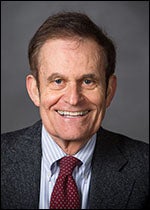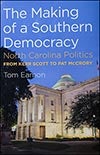MOVERS AND SHAKERS
ECU professor examines heart of state's political history

Tom Eamon
East Carolina University political science professor Tom Eamon tracks how North Carolina has politically evolved since the 1940s in “The Making of a Southern Democracy: North Carolina Politics from Kerr Scott to Pat McCrory,” published in January.
Eamon outlines the state’s stormy political and social history, explaining how North Carolina played a pivotal role in 21st century American history. He said the state has “often been a test tube for the political strains in American society,” with influential political figures that include Republican Senator Jesse Helms and Democratic Governor Jim Hunt.
The book begins immediately after World War II, with descriptions of how elections from this date to the present reflect the strengths and weaknesses of society, in addition to the foresight and shortcomings of state leaders.
“It is the most detailed coverage to date of North Carolina’s modern elections, a story of how and why they came out as they did,” Eamon said.
A native of Kinston, Eamon grew up in Durham. He earned a bachelor’s in political science from the University of the South in 1965. From UNC-Chapel Hill, he earned a master’s in political science in 1969 and a Ph.D. in political science in 1975.
Eamon is associate professor of political science at ECU.
Photos by Cliff Hollis
In the News
ECU professor Tom Eamon’s new book on North Carolina politics has triggered significant media attention.
 Eamon spoke on WUNC’s “The State of Things” and joined George Olson for segments to run during Public Radio East’s “Morning Edition.” Listen to the PRE recording. Listen to the WUNC interview.
Eamon spoke on WUNC’s “The State of Things” and joined George Olson for segments to run during Public Radio East’s “Morning Edition.” Listen to the PRE recording. Listen to the WUNC interview.
Articles about the book appeared in the News and Observer, the Charlotte Observer and the Durham Herald Sun. Read the N&O article here. Read the Durham Herald Sun article here.
Eamon was a guest on WPTF in Raleigh on the Tom Kearney Show. He appeared on Charlotte’s NPR station WFAE Jan. 17 and at book signings in Raleigh and Charlotte Jan. 17-18.
For additional information about the book, visit UNC press.
A: I grew up with a real passion for politics. Thanks to my father, I knew all the presidents’ names and states and capitals well before I could read. …To me, the big elections were even greater dramas than the World Series or college basketball championships.
There is a rich tradition of first-rate writing on North Carolina history and politics. But I dreamed of a book that would focus on the change in the period from the end of World War II to now. … I wanted to tell how and why the change came both in the society and in its politics, and to do it in a way that would provide both a book of record and one that would appeal to readers outside the ivory towers of academia.
A: Walk down the street in 2014. Then take a time capsule back to 1948. You enter a different world. The old cars would be fun to see. But psychologically, the obvious race caste system would be the most shocking.
The changes have been sweeping in many other respects: the development of a two-party system, more women in high office, and campaign techniques. At least in election influence, the “good ole boy” network has declined. Many elements fought change tooth-and-nail all the way.
To many, the word “revolution” suggests sudden change. Although there were many dramatic moments, this one lasted for decades. It may not be over. Like other revolutions, this one was people driven. It didn’t just happen.
A: Race and education have been primary issues and the ones most often discussed and debated. For a long time, the arguments related to race could be blunt and vicious. Now they are more subtle and often hide under the banner of other issues.
From 1900 to now, education – both K through 12 and university – have been on the front burner. Cost and quality issues figure into almost every campaign and legislative sessions.
Jobs and the economy are always concerns though politicians are limited in what they can do about them….The environment always looms as a big issue, but it takes a crisis to move to the forefront. Transportation is a perennial issue.
A: From early on, North Carolina was one of the poorest and most backward of states. It slept through much of the 1800s. Critics called it the ‘Rip Van Winkle” state.”
Early in the 20th century, some of the leadership began to focus on education and development. …From the mid-20th century, much of North Carolina’s political and business establishment preached economic development and education as holy causes. Universities sought to expand their scope and there was a vast expansion of medical facilities.
To a point, the results were dramatic. Major cities boomed. … The state emerged as a research center in medicine and many other fields.
Today, there is a gap. Many metropolitan areas and university communities are booming…. But farming areas once reliant on tobacco and old textile towns are withering and face high unemployment. … Despite great progress in many areas, North Carolina is a captive of its past.
A: …My study looks at the elections in much greater depth than earlier books on the premise that elections have been crucial in shaping politics. Also, I have made an effort to convey to readers the atmosphere and flavor of various periods of North Carolina and national history.
Moreover, I attempt to portray the personalities and explain the motivations of major political figures. This can be risky business, but I feel good about the outcome and my book makes the most serious effort yet to weave the relationship between national and state politics.
A: This story is my passion. As a young boy, I witnessed the tail end of the old order and the friction as widespread racial integration began in North Carolina and the South.
As a young man, I was acquainted with and watched closely many of the movers and shakers as well as ordinary citizens of North Carolina. And for several decades, I have talked about the subject almost every day in the classroom and other environments.